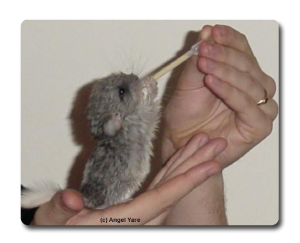 Breeding is a risky business, and unfortunately things do not always go well. Occasionally it is necessary for kits to have supplementary or replacement feeding in order to prosper, this can happen for a variety of reasons.
Breeding is a risky business, and unfortunately things do not always go well. Occasionally it is necessary for kits to have supplementary or replacement feeding in order to prosper, this can happen for a variety of reasons.
-
Mum may reject a kit at birth
-
Litters can be too large and not enough milk for all
-
Mastitis
-
Mum may die during the birth
-
Larger kits may bully the smaller ones
-
and more . . . .
Whatever reason you have, supplementary feeding is a time consuming, messy and difficult task, and in many cases you will still lose the kit. But when successful can be extremely rewarding.
Different breeders have different formulas for the milk substitutes that they use. Here are a few that I have come across, I have only used the top one from his list personally but have been told by other breeders that they have used the others with success.
50% Full Fat Cows Milk, 50% water
25% Evaporated Milk, pinch of Glucose and Water
50% Goats Milk, 50% Water
Kitekat/Wiskas kitten milk
Feeds should take place approximately every 2 hours, keep a close check on the kits weight the entire time that you are supplement feeding, and where possible keep the kits in with the mum for all time except when they are out to be fed, as she will look after and care for the kits even when she is unable to feed.
If you are unable to leave the kits with mum, and a foster mum is not available, then give them a furry cuddly toy to snuggle up against and leave them in a warm draft free place that is secure. If you have one available, place a kit warming lamp beneath the cage that they are in (this can me a 40w lamp bulb in an old biscuit tin - or professional heaters are available from some equipment suppliers)
If a foster mum is not present then when the feeding is complete, wipe down the kits mouth and head and then using a damp cotton wool ball wipe along the stomach from the front paws to the back end. This will stimulate the kit to defecate and is an essential part of the feeding ritual if there is not a mother about to do this for you.
If the kits weight should drop then increase feeds to hourly. If the kit takes more food and weight continues to increase then you can decrease the frequency to 3 hours, then 4 as the kit grows and ages - but remember the more feeds and frequency of them the better the overall growth of the kit is likely to be.
As kits do grow have hay and pellets available in the cage as they will pick at these in time as they develop - often earlier than any people would think.

